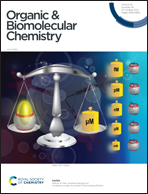Recent advances in rhodium-catalyzed C(sp2)–H (hetero)arylation
Abstract
Arylation is a common behaviour in organic synthesis for the construction of complex structures, especially the biaryls. Among those reported arylation procedures, transition-metal-catalyzed direct C(sp2)–H arylation has been rapidly developed in recent decades and has become a reliable alternative to traditional cross-coupling procedures using organometallic reagents. Great achievements in rhodium-catalyzed C(sp2)–H arylation have been witnessed during the last decade. Aryl halides, simple arenes, aryl boronic acids, arylsilanes, aryl aldehyde, aryl carboxylic acid, diazides, etc. were successfully utilized as arylating reagents under rhodium-catalyzed conditions. In this review, recent achievements in rhodium-catalyzed arylations through C(sp2)–H bond activation were summarized together with the mechanism discussions.

- This article is part of the themed collections: Synthetic methodology in OBC and Catalysis & biocatalysis in OBC


 Please wait while we load your content...
Please wait while we load your content...